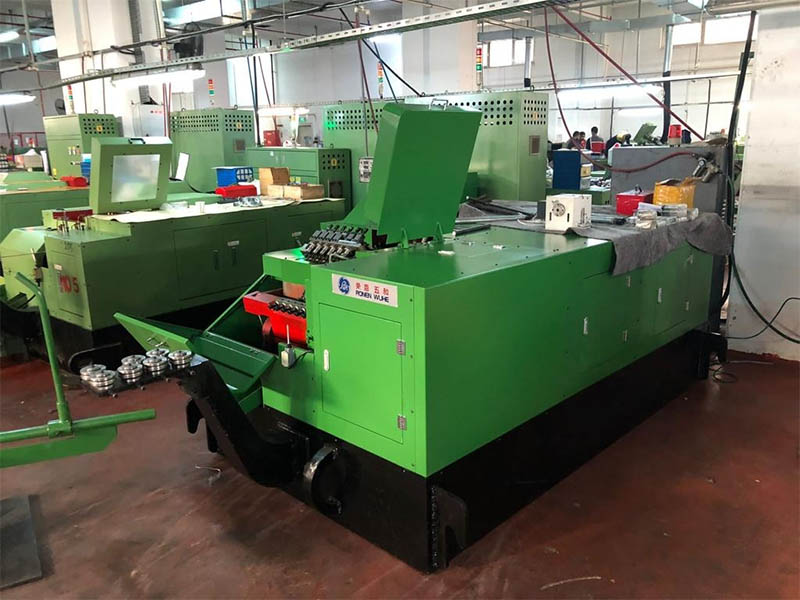
The 6 Die And 6 Below Nut Former Cold Forging Machine by manufacturer Ronen® completes the shaping of the nut blank through six forging processes in six steps: wire cutting, upsetting, hexagonal forming, punching, edge trimming, and final sizing. The wire does not require heating, thus saving energy.
6 Die And 6 Below Nut Former Cold Forging Machine uses six consecutive molds to shape the wire into a nut. "Six down" refers to six punches pressing into the mold from bottom to top. This device can gradually shape the metal block from a simple blank to a finished threaded nut.
Setting Nut Former Cold Forging Machine means aligning six sets of tools. Above each workstation there is a die, and below it there is a punch. These two must be perfectly matched. This precise setting is crucial for producing consistent-quality nuts. After this link is implemented, the equipment will not require frequent intervention and only minor adjustments will be needed to ensure long-term continuous operation.
A key component of the Die And 6 Below Nut Former Cold Forging Machine is the system used to move the nut blanks between six workstations. This conveying mechanism must be extremely reliable to ensure the smooth operation of the high-speed process. If there is any out-of-sync situation, it may cause jamming and result in defective parts.
You can configure a Nut Former Cold Forging Machine for different types of nuts. By replacing six sets of punches and molds, the same machine can be used to produce standard hexagonal nuts, heavy-duty hexagonal nuts, and even nuts with flanges, providing excellent flexibility for the manufacturing workshop.
| Specification | Unit | 11B | 14B | 17B | 19B | 24B | 27B | 30B | 33B | 36B | 41B |
| Forging Station | No. | 6S/7S |
6S/7S |
6S/7S |
6S/7S |
6S/7S |
6S/7S |
6S/7S |
6S/7S |
6S/7S |
6S/7S |
| Max Cut-Off Dia | mm | 11 | 15 | 17 | 19 | 24 | 28 | 30 | 33 | 36 | 41 |
| Kick-out Length | mm | 20/30/40 | 20/30/40 | 25/40/60 | 25/30/40/60/80 | 30/60/80 | 30/40/60/80 | 30/40/60/80 | 40/60/80/100 | 50/60/80/100 | 50/60/80/100 |
| Dies Pitch | mm | 50 | 60 | 70 | 80 | 100 | 110 | 120 | 140 | 150 | 165 |
| Forging Power | Ton | 60 | 90 | 110 | 135 | 230 | 260 | 300 | 360 | 420 | 650 |
| Production Size |
|
M3-M6 | M6-M10 | M8-M12 | M8-M14 | M10-M18 | M12-M18 | M14-M20 | M16-M22 | M18-M24 | M20-M27 |
| Output | min/pcs | 250 | 180 | 150 | 140 | 70 | 60 | 60 | 90 | 80 | 70 |
| Main Motor | Hp | 15 | 20 | 30 | 50 | 75 | 100 | 125 | 150 | 250 | 350 |
| Lubrication Motor | Hp | 1.5 | 1.5 | 1.5 | 1.5+3 |
1.5+3 |
1.5+3 |
1.5+3 |
1.5+3 |
1.5+3 |
1.5+3 |
| Lubricant | L | 700 | 1000 | 1100 | 1200 | 1700 | 2300 | 2000 | 2400 | 2400 | 2400 |
| Approx Weight | Ton | 4.5 | 8 | 11 | 14 | 25 | 38 | 42 | 45 | 70 | 73 |
The features of the Die And 6 Below Nut Former Cold Forging Machine are that it has comprehensive station functions and wide material compatibility. If you want to perform chamfering, use the 5-station model; To produce anti-slip patterns, simply switch to the 4-station mold without any additional equipment. Each station's mold is independent, and if one mold is damaged, just replace it with the corresponding one. It is very convenient.
